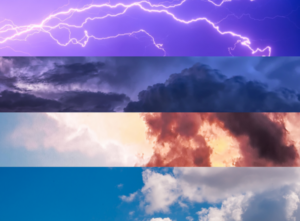4 Types of Everyday Weather Consumers Care About

There’s no such thing as a quiet weather day. There is always something happening or forecast to develop that is of interest to somebody somewhere.
When I was an on-air broadcast meteorologist, most of the questions I got from viewers weren’t about severe weather or hurricanes. Yes, there were some of those. But collectively, throughout the year, most people asked about specific parts of the forecast or seemingly minor issues.
 Boaters were curious about a change in the wind direction. Allergy sufferers wanted to know when pollen levels spiked. Pregnant women were interested in the next low pressure or full moon. Construction workers wanted to make sure a surprise shower wouldn’t delay a concrete pour. These people, and many others just like them, looked for small changes in the weather.
Boaters were curious about a change in the wind direction. Allergy sufferers wanted to know when pollen levels spiked. Pregnant women were interested in the next low pressure or full moon. Construction workers wanted to make sure a surprise shower wouldn’t delay a concrete pour. These people, and many others just like them, looked for small changes in the weather.
As a communications coach working with broadcast meteorologists, I remind my clients that all weather matters. Severe weather has a significant impact on the greatest number of people. However, smaller weather events are just as important to those affected by them, mainly because they happen more often.
Do the math
Statistically, severe weather only develops a few dozen times a year. According to data compiled by the Storm Prediction Center, most locations east of the Rocky Mountains only average 15-30 severe weather days per year. Assuming broadcast meteorologists talk about the threat of severe weather at least five days before the event, there are still about 150-200 days a year when there are no storms to track.
Even during the 2020 hurricane season, the most active on record, there were many days with no tropical activity.
It’s natural for broadcast meteorologists to focus on the big storm. Much of their education concentrates on studying the thermodynamic forces that generate severe weather and hurricanes. TV stations build elaborate weather centers, invest in expensive radars, and promote their weather team as the local weather authority.
But local TV stations produced multiple hours of news every day. We can’t build a dedicated audience and loyal following if we only focus our coverage on major weather events. There’s simply not enough of them!
READ MORE: METEOROLOGY MARKETING BUILDS WEATHER AWARENESS AND BRAND LOYALTY
Broadcast meteorologists can build a loyal following by delivering essential information every weather hit, every day. That’s the promise behind Meteorology Marketing, a key concept in the virtual coaching program. Engage the viewer by focusing on the weather that matters to them. Realize what matters to them might not be a big storm.
If it’s not severe, it’s something else
To help broadcast meteorologists identify the weather story of the day, I grouped all types of weather into one of four different categories. There is always something occurring or forecast to form that fits one or more of these categories.

Severe Weather includes thunderstorms, tornadoes, hurricanes, flooding, heavy snow, and blizzard conditions. In some parts of the country and at certain times of the year, wildfires, coastal flooding, and extreme heat could also be considered severe weather events.
These types of weather events are easy to identify. They have the potential to cause extensive damage, injuries, and death. The National Weather Service almost always issues a watch or warning for severe storms.
TV newsrooms gear up to cover these significant weather events. Producers add extra weather hits to the newscasts. Cutins and push alerts might be required. These are “Big Game” moments. Reputations are built and lost based on how broadcast meteorologists cover severe weather.

Disruptive Weather events are not severe but still have a significant impact on people. The National Weather Service sometimes issues advisories, but not always. Lightning storms, for example, do not generate warnings or advisories, but they can be highly disruptive (and dangerous!)
For farmers and ranchers, extreme drought is disruptive to their livelihood. Wildfire smoke and high pollution levels are disruptive for people who have respiratory problems. Temperatures in the upper 90s are disruptive for people without air conditioning. A hard freeze is disruptive for people who just planted a garden or landscaped their yard.
When you think about it, there are more types of disruptive weather events than severe weather events. These storms might eventually get strong enough to be considered severe, so they should be monitored closely.
MORE ON RTDNA: HOW ONE TV STATION COVERS DISRUPTIVE WEATHER
If broadcast meteorologists wait for a warning to be issued, they’ve waited too long. A storm that’s producing heavy rain, 30-40 mph winds, and pea-size hail won’t prompt a warning from the National Weather Service, but it’s still concerning to people at home or those outdoors in the weather. It might not be a “severe” storm, but it’s still a disruptive weather event.
Furthermore, how will viewers and followers know a storm is not strong enough to cause damage unless we tell them?

Inconvenient weather develops so often it might be considered “normal.” These events are usually short-lived or limited to smaller areas. They can be more challenging to identify, but they are just as important to people affected by them.
Light rain showers on a major road during rush hour can slow down traffic significantly. Saharan dust or smoke from distant wildfires might make the sky look hazy and reduce visibility. Higher than usual tide levels are a concern for people living along the coast. A sudden drop in temperatures will send people looking for a sweater or jacket. An increase in humidity can make it extremely uncomfortable.
Weather watches, warnings, and advisories aren’t required for inconvenient weather events. Broadcast meteorologists don’t need to cut into programming or send out push alerts. However, they still might be part of the essential message you deliver on-air, online, and on social media. You could build your entire weather hit around an inconvenient weather event.
There’s almost always something inconvenient about the weather if you look for it. Except for those days when the weather is perfect. Even that type of weather event is worth recognition.

Optimal weather is the fourth type of weather. It doesn’t happen very often, but we should acknowledge it when weather conditions are simply perfect.
Consumers often accuse the media of only pointing out the bad things happening, sometimes with good reason. Drawing attention and celebrating optimal weather conditions helps balance the overall weather coverage. It gives you and the viewers a chance to pause and enjoy the weather occasionally.
During a week of rain, a dry day is welcomed by most people, just as a brief shower is during a drought. A clear sky is perfect for stargazing or watching the International Space Station pass overhead. Nothing beats a sunny day, with temperatures in the 70s with low humidity.
I used to issue a Rainbow Watch and Rainbow Warning during my weathercasts when I worked on-air. Viewers loved it and usually responded by filling my inbox with pretty pictures.

Sean Sublette, Chief Meteorologist at the Richmond Times-Dispatch and formerly with Climate Central, suggested a fifth type of weather that consumers care about: unusual weather.
“When the weather is much different from normal, even if the impacts are not especially great, it gets people talking and wondering what is going on. Perhaps it was an especially wet week, a particularly dry month, or there were multiple consecutive days much warmer or colder than normal.”
Highlighting usual weather patterns is an excellent way for broadcast meteorologists to demonstrate their expertise, one of the components of Meteorology Marketing. Explaining the what, along with the why and how, helps viewers develop a deeper appreciation and understanding of the science of meteorology.
“When there is a perceptible difference from climatology, meaning the weather is beyond regular expectations for the location and time of year, many will want to know why,” Sublette says.
Total Weather Coverage
The categories above are a hierarchy. If no severe storms threaten the local area, look for weather events that are almost severe and strong enough to be disruptive. Look for smaller events that might be inconvenient for some people. And if nothing else, highlight moments when the weather is simply perfect.
 This idea of covering smaller events does not suggest broadcast meteorologists should hype their weather coverage! That’s not the point. You probably won’t do an extra weather hit for a brief thundershower. But you might if it’s affecting enough people. Explaining why tides are higher than usual would be an excellent digital story for the website. And those rainbow pictures mentioned above are great social media content. Finding the weather story of the day should go beyond identifying the next big storm.
This idea of covering smaller events does not suggest broadcast meteorologists should hype their weather coverage! That’s not the point. You probably won’t do an extra weather hit for a brief thundershower. But you might if it’s affecting enough people. Explaining why tides are higher than usual would be an excellent digital story for the website. And those rainbow pictures mentioned above are great social media content. Finding the weather story of the day should go beyond identifying the next big storm.
Demonstrate that you are a source of helpful, essential, valuable weather information. Show your audience that you care. Keep your viewers and followers safe, but also help them live a happy, healthy life. Do that every day and folks will establish a habit of watching you. Then when the weather does turn severe, they’ll know who to watch because you’ve earned their trust.
Tim Heller is an AMS Certified Broadcast Meteorologist, Talent Coach, and Weather Content Consultant. He helps local TV stations and broadcast meteorologists communicate more effectively on-air, online, and on social media.
